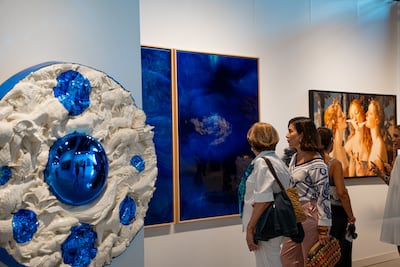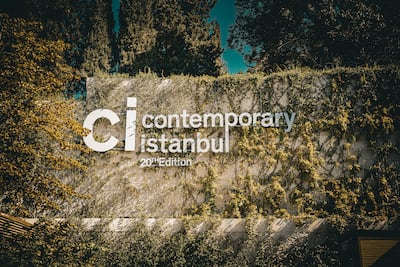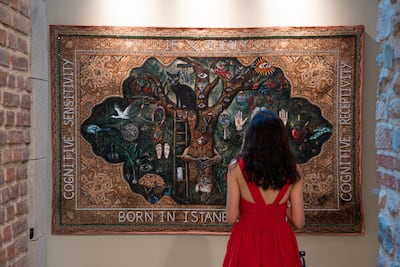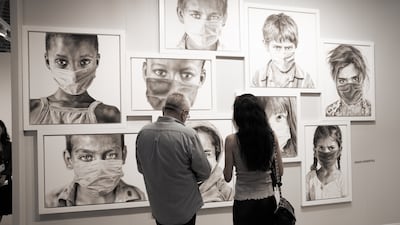Contemporary Istanbul celebrated its 20th anniversary at the weekend, gathering 51 galleries from 16 countries to mark two decades as Turkey’s leading international art fair.
The fair, which also featured 10 cultural foundations, was held from Wednesday to Sunday at Tersane Istanbul – the former Ottoman shipyard restored as a cultural hub and now CI’s permanent home.
“When I first started CI all those years ago, the goal was always quality over quantity,” CI founder Ali Gureli tells The National. “I had just visited Art Basel and thought, ‘we can do something similar in Istanbul', because it’s a city that deserves an art scene with strong galleries and artists, where we can bring the world to us and celebrate all the city has to offer.

“There was no real art market in Turkey at the time, but slowly, one developed. Having galleries from across the world present in Istanbul allowed people to exchange ideas and philosophies, and that sparked the vibrant ecosystem we now have. Young people became interested, and today, there is an entire generation of collectors in Turkey. Many began with antiquities, then moved into modern and contemporary art. Now, there is a third generation of very young collectors and artists, so we feel a responsibility to help shape the future of Turkey’s art scene.”
Initiatives such as covering customs fees for artworks and offering free air cargo through partnerships have been central to the fair’s growth, enabling galleries from financially strained markets to participate.
In recent years, the organisers have also watched closely as the Middle Eastern art scene has undergone rapid expansion. The region’s boom – including Abu Dhabi’s $1 billion investment in shares of Sotheby’s and Mena broadly generating $3 billion from art-related tourism last year – is of clear interest to CI, which hopes to strengthen ties with Gulf institutions and galleries.
“Historically, CI has hosted plenty of Middle Eastern galleries, and six years ago, we had a focus section on the Gulf,” says Sarp Kerem Yavuz, artistic director of the Contemporary Istanbul Foundation. “What the regional boom means is that we’re going to see more traffic from Western countries now realising the scale of the market here.

“The upcoming Art Basel Qatar and the Zayed National Museum opening this year are excellent indicators of that shift. There’s a gradual move towards this region, and we all benefit. I’m excited about the partnerships we’ll be able to build with these new museums, because there’s a real overlap in the conversations we’re having and in the interests of Western audiences.
“We could easily create an itinerary where visitors stop in Istanbul, then Dubai, Abu Dhabi and Doha. There are huge opportunities to present the region’s art ecosystem as a whole.”
This year’s event was spread across two major halls at Tersane, alongside public installations around the complex. The Focus section spotlighted America, with a particular emphasis on New York.
Leila Heller Gallery, which has outposts in Dubai and New York, participated with a selection of Turkish and international names, including Syrian artist Kevork Mourad and Dutch–Swedish duo Ryan Koopmans and Alice Wexell.
“Koopmans and Wexell travel the world finding abandoned heritage sites – palaces, mosques, even some here in Istanbul – and bring them back to life through photographic interventions, adding flora and fauna,” gallery founder Leila Heller says. “With Kevork, we showed two works. His practice is all about humanity and fragility, often using paper cut-outs and fabric to create compositions of bones or limbs, like fragile cityscapes showing the destruction of urban environments.”

Other regional participants included Beirut’s Mark Hachem Gallery, London/Dubai’s JD Malat Gallery and Dubai's AWC Contemporary Gallery. AWC displayed a range of international artists, from quirky installation pieces to ambitious textiles. Highlights included award-winning Portuguese artist Joana Vasconcelos’s striking fabric works, and The Feast of Earthly Delights by Turkey’s Vildan Hosbak – a detailed miniature banquet table enclosed in glass, which on closer inspection revealed macabre undertones.
“This was our second time showing at Contemporary Istanbul and it went really well,” says AWC founder Haldun Kilit. “Some of our artists even produce sculptures here in Turkey, which we then take to Dubai. Collectors today aren’t necessarily focused on nationality – they’re looking for good art.”
Looking ahead, CI plans to expand further by completing renovations on another historic building in the Tersane complex, which will allow the fair to host around 25 additional galleries for its next event.

